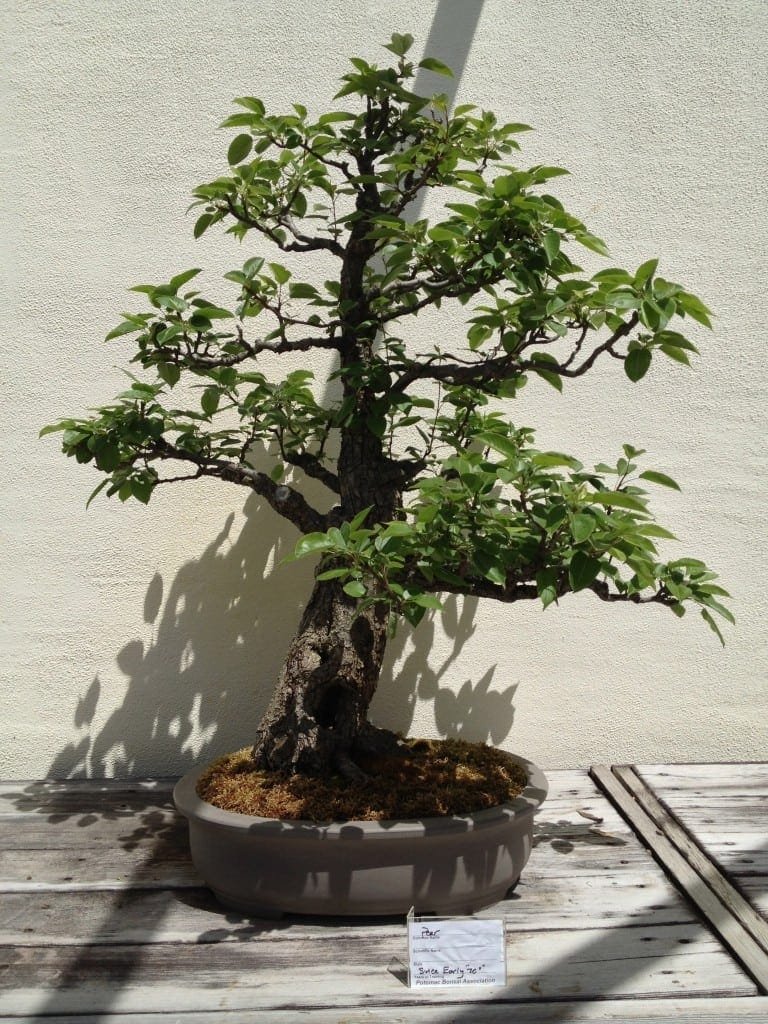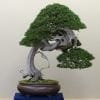The Serissa bonsai is a unique, beautiful bonsai tree. Bonsai enthusiasts love it for its ever-present white flowers that gave it the nickname “Tree of a Thousand Stars”. And the Serissa has more than just beautiful foliage to offer.
It also grows remarkably fast and responds well to severe pruning. All of these attributes combined make the Serissa bonsai one of the most pleasant and rewarding bonsai trees available.
| Scientific/Botanical Name | Serissa foetida or Serissa Japonica |
| Description | Serissa is an evergreen, sub-tropical tree with gorgeous white blooms all year long. The trunk has a rough texture, and the spiny branches grow up and out which, together with the leaves, create a dome-like canopy. |
| Position | Serissa is very particular about its growing location, and even though the tree dislikes being moved about, this may be necessary to give it a happy home. When grown indoors, the tree requires between six and eight hours of direct sunlight. It should not be placed on a windowsill, however, because it dislikes the temperature variations. Additionally, it must be placed outside in spring or summer for a few weeks each year. The tree can be grown outdoors year-round in a sub-tropical climate. |
| Watering | The tree must be kept consistently moist. Maintain a regular watering schedule that allows the top two-thirds of the soil to become dry, and then water thoroughly. |
| Feeding | Feed the tree twice a month during the growing phase. Reduce feeding to once per month over the fall and winter season. Do not feed the plant when the leaves have fallen off, or growth has ceased. Feed with a liquid form of bonsai fertilizer according to application instructions. It is important for the soil to be moist when the plant is fertilized. This eliminates the risk of root burn. |
| Leaf and Branch Pruning | Prune to desired shape in early springtime, then again in the fall if needed. Hard cutting-back promotes the growth of root suckers, but these may be safely removed by pruning. |
| Re-potting & Growing Medium | Serissas prefer to remain in the same containers, but rampant growth means that young plants must be re-potted every year. This should be undertaken in the spring before new growth begins. When re-potting, expose the roots and trim well. Mist the plant well after re-potting. Use good quality bonsai soil for re-potting. |
| Wiring | The plant is easy to shape with wires. The branches remain pliable into maturity, so wiring can be carried out at any time. Ramification can be achieved within three years because of Serissas quick growth rate. |
| Notes | The tree has many favorable attributes that commend it to the art of bonsai, and it can be shaped into some very visually-stunning and graceful styles. |
Climate
The Serissa is a subtropical bonsai tree. In most areas of the world it must be grown indoors where temperatures remain warm and the air is humid.
When grown indoors, Serissa bonsais prefer a bright spot where they receive direct sunlight for six to eight hours a day. Do not place your Serissa bonsai near a windowsill. During cold nights or days, temperatures may fall too far for the Serissa bonsai to handle.
Also avoid spots near radiators or air conditioner/heating vents. Serissas do not like drafts or excessive heat (if the best spot for your Serissa only receives poor or indirect sunlight, install a grow light. Keep it on for 12 hours during the day time to provide the supplemental light your bonsai needs to grow and flower healthily).
Any untenable conditions may cause the Serissa’s leaves to turn yellow or drop off. Prolonged exposure may eventually stunt or even kill the plant. Once you find a suitable spot, keep your Serissa bonsai there.
Serissas do not like to be moved frequently. Frequent changes in their surroundings — no matter how small — may cause the Serissa’s leaves to drop or turn yellow.
Wherever the Serissa grows, it must be kept quite humid. Fill a planting tray with pebbles and place it underneath the Serissa’s planting container. It will collect the run-off water from the planting container and slowly release it into the air to raise the humidity level in the air directly around the plant.
Although it needs the indoor warmth, it must spend at least a few weeks of the year outside in late spring or summer when outdoor temperatures are warm. In subtropical areas, the Serissa bonsai may be grown out doors year-round. Whatever the time of year or climate, your Serissa bonsai must not be exposed to temperatures that fall below 7 degrees celsius.
Watering
Serissa bonsai trees enjoy consistency above all. Water your Serissa at regular intervals whenever the soil is almost completely dry. Check the soil’s moisture level twice daily by sticking a finger into the soil down to the bottom of the container. When the very bottom layer is still barely moist and nearly dry, give your Serissa bonsai a nice, long drink.
Water the soil with a watering can until water drips out of the drainage holes in the bottom of the Serissa bonsai’s container. Check the Serissa bonsai’s pebble-filled planting tray 15 minutes after you water. It should be filled with water but not overflowing. Empty some of the water if it is preventing the soil in the Serissa bonsai’s container from draining readily. Add a little less water next time.
After you water your Serissa bonsai and check its planting tray, mist the plant’s foliage with water. A fine spray over the entire plant will help increase humidity levels. This misting is especially important just after repotting. The Serissa will draw some of its water from its leaves while it waits for its pruned roots to re-establish themselves.
Fertilizer
Fertilize your Serissa bonsai once every two weeks during the growing season when the tree is actively growing. In fall and winter, reduce feeding frequency to one feeding per month. Do not fertilize if your Serissa has just dropped its leaves (wait a few weeks for them to grow back) or if it is not currently producing new growth.
Use a balanced liquid bonsai fertilizer and follow the label’s instructions for application methods and amounts. Never apply fertilizer to dry soil. You may burn your Serissa’s roots.
Pruning
Serissa may be particular about its growing conditions but it is a hardy plant that stands up to even sever pruning. Prune to shape as you will. Serissa bonsai trees respond really well to directional pruning and produce great ramification. But be aware that hard pruning will cause the Serissa bonsai to produce root suckers. Simply prune these suckers off at their base whenever they pop up.
The best time to prune Serissa bonsai trees is in early spring. Let the tree grow out in summer to help it handle heat stress then prune again in fall if necessary.
Shaping
Serissa bonsai is one of the easiest bonsais to shape. Its branches are quite flexible and even old, thick branches respond well to wiring. And because the Serissa grows quickly, you can get ramification in as little as two to three years.
Repotting
Serissa bonsai trees do not like to be repotted but will bounce back well enough if repotted in spring at the beginning of the growing season. Serissa bonsai trees are fast growers, especially when they are young. During its first few years of growth you may have to repot your Serissa bonsai once a year.
Pay close attention to its roots as it grows. It may quickly outgrow a small pot and it hates being root bound. In a pinch you can repot Serissa at any time during the active growing season. Bare the Serissa bonsai’s roots when you repot, prune them and replant the tree using balanced well-draining bonsai tree soil.
Difficulties
You can find Serissa bonsai at many nurseries and retail establishments that sell bonsai trees. But the Serissa bonsai’s ubiquity is misleading. Serissa bonsai may be a popular genus of bonsai tree, but it is notoriously difficult to grow. Novice bonsai enthusiasts should stay away from this temperamental beauty that religiously drops or yellows its leaves at the mere hint of inconsistent care.


